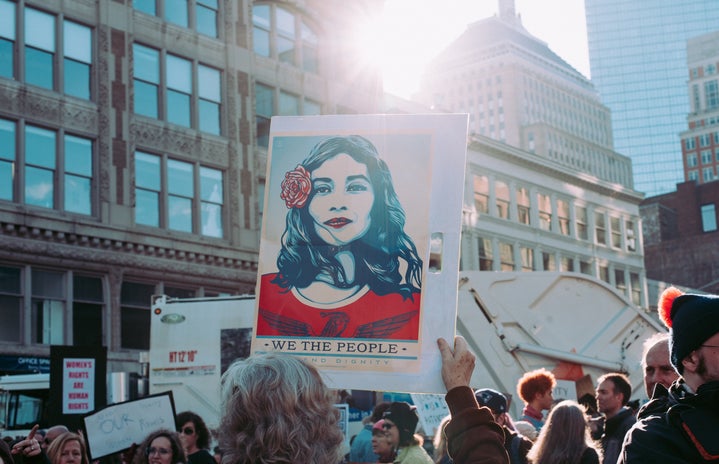At noon on Saturday, January 19, a person would have found it simply impossible to cross Government Street. In their path would have been hundreds of people marching in the third annual Women’s March, an event which aimed to bring attention to the violence facing women.
According to the Washington Post, the first ever Women’s March in 2017 saw nearly 4 million people throughout the United States take to the streets in response to the inauguration of current U.S. President Donald Trump.
On January 21, 2017, I was among the more than five thousand people who gathered at Washington Square Park in Kansas City, Missouri. It was one of the most surreal experiences of my life. Several speakers addressed various social issues, including religious freedom, immigration, and equal pay, as well as reproductive and LGBTQ rights. One after another, they took to the podium, some sharing emotional and deeply personal stories, others advocating for equal rights for all.
I am proud to say that I was a part of that historical day, and three years later, I was excited to attend the Women’s March in Victoria.
There were various differences between the two events, but to me, they were the same in all of the ways that matter. At the core, these two events were both a result of ordinary people willing to challenge the status quo surrounding them. At their core, these two events demanded change, advocated for equality, and brought awareness to the disparities facing women and minorities today.
Controversy around the marches
In the time between my standing with five thousand in Kansas City and marching with hundreds in Victoria, the original organizers of the Women’s March in Washington, D.C.—who are now a nonprofit organization called Women’s March, Inc.—faced controversy, and some groups have distanced themselves from the organization.
On a national level, the Women’s March, Inc. leaders have recently been accused of anti-Semitism and, according to the Washington Post, been ridiculed for not condemning the anti-Semitic head of the Nation of Islam, Louis Farrakhan. On a local level, some American cities, including Philadelphia and New York, have seen controversy surrounding this year’s Women’s March and even had two seemingly competing marches take place on January 19.
Even some aspects of international marches, like the one in Victoria, were not without contention.
Victoria organizers issued a statement on “pussy hats” prior to their event. In their official public statement, the organizers discussed the symbolism of the hats as perpetrators of “the concept of shared womanhood, which ignores the complex ways in which women face different levels of marginalization based on race, sexual orientation, gender presentation, class and disability status.”
The organizers made it clear in their statement that they were committed to inclusivity: “We want everyone to feel safe and welcome at the march. Wearing one of these toques displays a lack of empathy and understanding towards the various manifestations of gender.”
Organizers instead encouraged participants to sport red scarves at the march “to bring awareness to the disproportionate violence faced by Indigenous women and girls.” They also announced that they are “working closely with the Moosehide campaign . . . Bridges for Women . . ., and Rainbow Health Co-Op” in adherence with the 2019 theme of the Women’s March of ending violence.
Perspective on the pussy hats
I see the merit behind all of the statements made in this policy. I feel the symbolism behind these hats does fail to take into account the nuances of reality and I am happy to see such a discussion taking place.
However, for me, the pussy hats have always been very clearly and directly linked to the 2005 statement made by Donald Trump in the now famous Access Hollywood video. In the video, Donald Trump infamously says, “When you’re a star, they let you do it. You can do anything. Grab ’em by the pussy. You can do anything.”
In the first Kansas City march I attended in 2017, I saw a wide variety of people sporting the hats, and I saw it as a very direct and visual response to Donald Trump’s vulgarity. So for me, it was invigorating to see so many people who felt empowered to so visually share their disgust for the newly inaugurated president.
It was political protest like I had never seen it before, and it was exciting.
That being said, I recognize the ability of symbols to evolve over time, and I think that is what’s happening here. The hat has become a broader symbol for the Women’s March movement and women’s rights in general.
In this evolved context, yes, the symbolism of pussy hats is more complex and has the ability to exclude some people.
The nuances of reality are constantly changing, especially as this movement becomes more global, causing certain symbols to fall out of prominence. However, those hats will always remind me of the day that 4 million people took action.
The future of the movement
The complexity surrounding pussy hats is a sort of case study for the complexity surrounding the concept of the Women’s March as a whole. As movements diverge and some leaders prove that they are not up to the task, how can the movement remain united on such a large scale?
For me, it comes down to the core of the movement. As I said before, the reason why my experiences at the Women’s March in Kansas City and the Women’s March in Victoria were different yet so strikingly similar is because the core of this movement is so simple.
Women and minorities are demanding a change to the status quo they are so familiar with. Yet this movement is endowed with a certain amount of versatility because of its global scale. While at the core of it, all people in Victoria and Kansas City are fighting against the same obstacles, they face subtle differences. These differences mean that this movement manifests as different solutions in different places.
Like any movement of this scale, the Women’s March will always contain a certain level of conflict, but as the marches this year have shown, that conflict won’t cause a collapse of the global movement.
People around the world believe in this movement, and ultimately, change will come from that, but the change will be just as diverse and varied as the people who bring it.


